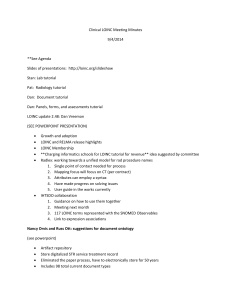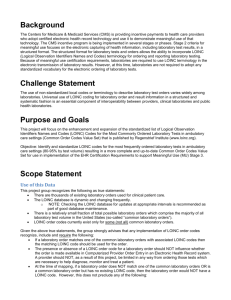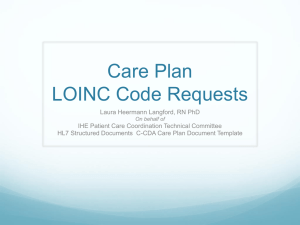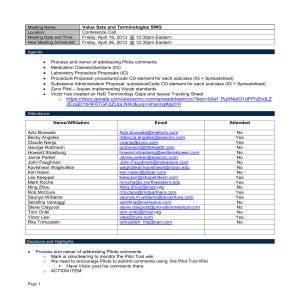ELINCS Proposal Response Submitted by ACLA
advertisement
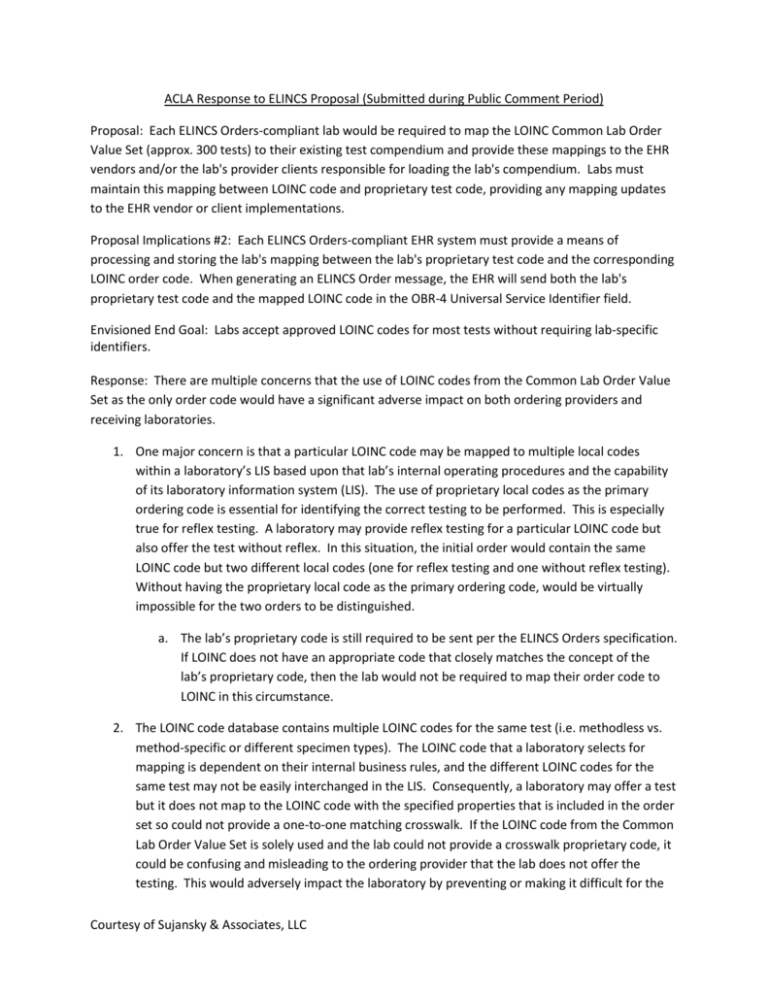
ACLA Response to ELINCS Proposal (Submitted during Public Comment Period) Proposal: Each ELINCS Orders-compliant lab would be required to map the LOINC Common Lab Order Value Set (approx. 300 tests) to their existing test compendium and provide these mappings to the EHR vendors and/or the lab's provider clients responsible for loading the lab's compendium. Labs must maintain this mapping between LOINC code and proprietary test code, providing any mapping updates to the EHR vendor or client implementations. Proposal Implications #2: Each ELINCS Orders-compliant EHR system must provide a means of processing and storing the lab's mapping between the lab's proprietary test code and the corresponding LOINC order code. When generating an ELINCS Order message, the EHR will send both the lab's proprietary test code and the mapped LOINC code in the OBR-4 Universal Service Identifier field. Envisioned End Goal: Labs accept approved LOINC codes for most tests without requiring lab-specific identifiers. Response: There are multiple concerns that the use of LOINC codes from the Common Lab Order Value Set as the only order code would have a significant adverse impact on both ordering providers and receiving laboratories. 1. One major concern is that a particular LOINC code may be mapped to multiple local codes within a laboratory’s LIS based upon that lab’s internal operating procedures and the capability of its laboratory information system (LIS). The use of proprietary local codes as the primary ordering code is essential for identifying the correct testing to be performed. This is especially true for reflex testing. A laboratory may provide reflex testing for a particular LOINC code but also offer the test without reflex. In this situation, the initial order would contain the same LOINC code but two different local codes (one for reflex testing and one without reflex testing). Without having the proprietary local code as the primary ordering code, would be virtually impossible for the two orders to be distinguished. a. The lab’s proprietary code is still required to be sent per the ELINCS Orders specification. If LOINC does not have an appropriate code that closely matches the concept of the lab’s proprietary code, then the lab would not be required to map their order code to LOINC in this circumstance. 2. The LOINC code database contains multiple LOINC codes for the same test (i.e. methodless vs. method-specific or different specimen types). The LOINC code that a laboratory selects for mapping is dependent on their internal business rules, and the different LOINC codes for the same test may not be easily interchanged in the LIS. Consequently, a laboratory may offer a test but it does not map to the LOINC code with the specified properties that is included in the order set so could not provide a one-to-one matching crosswalk. If the LOINC code from the Common Lab Order Value Set is solely used and the lab could not provide a crosswalk proprietary code, it could be confusing and misleading to the ordering provider that the lab does not offer the testing. This would adversely impact the laboratory by preventing or making it difficult for the Courtesy of Sujansky & Associates, LLC test to be ordered due to the unavailability of the alternate LOINC code in the Common Lab Order Value Set. 3. To take point #2 a step further, what happens if a lab offers a test with a particular LOINC code using certain specimen types but an ordering provider assumes a lab accepts a different specimen type (having a different LOINC code that the ordering provider isn’t aware of) but it has not been validated by the lab and therefore is not usually offered? 4. LOINC codes for panels present a particularly difficult situation as the components of the panel offered by the lab may not match with the components of the panel in the Common Lab Order Value Set (i.e. Complete Blood Count with Differential). It may be difficult for the ordering provider to recognize and/or fully understand these differences. This also becomes a compliance issue as a LOINC code ordered from one laboratory may not match the same LOINC code ordered from another laboratory even though, based on the ordering code, the tests appear to be the same. Consequently, the ordering provider may not receive the testing they think they are ordering based upon the LOINC code. In addition, the reporting format for panel components is dictated by a laboratory’s LIS. There may be different LOINC codes for a component reported individually vs. the component reported in a group or as a comment. 5. If the end goal is to use LOINC Codes as the Common Lab Order Code, will the lab also be required to use the LOINC Names? The federal government requires orders to be SPECIFIC and clear to the authorized provider what is being ordered. Many LOINC Names do not meet this requirement, which would create confusion for both the ordering provider and receiving laboratory. 6. The Common Order value set contains a very limited number of tests. Based upon the typical 3,000 tests performed by a given laboratory, the data set is less than 10% of the tests offered. In addition, based upon the issues listed above, a laboratory may only be able to crosswalk 3040% of the tests listed in the Common Lab Order value set, which creates a unique and very different process for a very small group of tests. It would necessitate the laboratory having two distinct processes for handling incoming orders, which would put an undue burden on the lab for managing these different processes. In summary, it may be reasonable to consider including the LOINC code from the Common Lab Order Value Set as part of the electronic order where there is an existing one-to-one matching crosswalk with the laboratory’s proprietary local code. However, the envisioned end goal of only using the LOINC code as the order code will unduly impact both the patient and the laboratory. It is essential that the end goal is to maintain the lab’s proprietary local code as the primary order code. Courtesy of Sujansky & Associates, LLC



